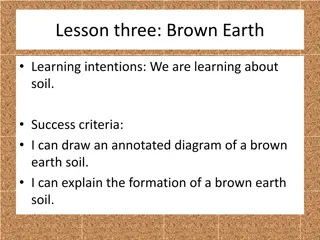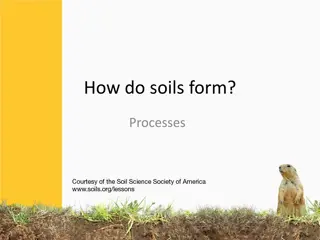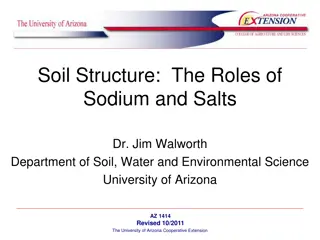Understanding Soil Formation: Factors and Processes Explained
Soil formation is a complex process influenced by factors like parent material, topography, climate, organisms, and time. This article delves into the fundamentals of soil evolution, discussing how soils are formed from weathered rock materials and the role of pedogenesis. Factors affecting soil formation, such as climatic conditions and prevailing processes, are also explored in detail.
Download Presentation

Please find below an Image/Link to download the presentation.
The content on the website is provided AS IS for your information and personal use only. It may not be sold, licensed, or shared on other websites without obtaining consent from the author. Download presentation by click this link. If you encounter any issues during the download, it is possible that the publisher has removed the file from their server.
E N D
Presentation Transcript
GOVERNMENT COLLEGE FOR WOMEN (AUTONOMOUS) KUMBAKONAM DEPARTMENT OF GEOGRAPHY I M.Sc - GEOGRAPHY APPLIED GEOMORPHOLOGY External Processes SOIL FORMATION
UNIT: II UNIT: II APPLIED GEOMORPHOLOGY APPLIED GEOMORPHOLOGY External Processes External Processes - - SOIL FORMATION SOIL FORMATION Definition of SOIL FORMATION: What is soil formation? Soil Formation is the process whereby fragmental material resulting from rock weathering is transformed into a medium that can support plant growth. When they are using soil formation than using physical disintegration and Chemical decomposition of rocks.
What are the five fundamental factors of soil formation? The evolution of soils and their properties is called soil formation, and pedologists have identified five fundamental soil formation processes that influence soil properties. These five state factors are parent material, topography, climate, organisms, and time. Parent material is the initial state of the solid matter making up a soil. How are soils formed? Primarily soils are formed from rocks through physical and chemical weathering. If weathered rock material remains over a parent rock then the soils are known as Residual soils. If weathered material is transported and deposited at some other location then the soils are called Transported Soil.
What is the process of soil formation called? The soil formation process is termed 'pedogenesis'. Climatic conditions are important factors affecting both the form and rate of physical and chemical weathering of the parent material. What factors affect the formation of soil? In addition to the soil parent material, soil formation is also dependent upon other prevailing processes affecting soil formation. The soil formation process is termed 'pedogenesis'. Climatic conditions are important factors affecting both the form and rate of physical and chemical weathering of the parent material.
SoilFormation: As stated at the beginning of this article, soils evolve under the action of biological, climatic, geologic, and topographic influences. The evolution of soils and their properties is called soil formation, and pedologists have identified five fundamental soil formation processes that influence soil properties. These five state factors are parent material, topography, climate, organisms, and time. Parent Material: Parent material is the initial state of the solid matter making up a soil. It can consist of consolidated rocks, and it can also include unconsolidated deposits such as river alluvium, lake or marine sediments, glacial tills, loess (silt-sized, wind-deposited particles), volcanic ash, and organic matter (such as accumulations in swamps or bogs). Parent materials influence soil formation through their mineralogical composition, their texture, and their stratification (occurrence in layers).
Dark-coloured ferromagnesian (iron- and magnesium- containing) rocks, for example, can produce soils with a high content of iron compounds and of clay minerals in the kaolin or smectite groups, whereas light-coloured siliceous (silica-containing) rocks tend to produce soils that are low in iron compounds and that contain clay minerals in the illite or vermiculite groups. The coarse texture of granitic rocks leads to a coarse, loamy soil texture and promotes the development of horizons (the leached lower regions of the topmost soil layer). The fine texture of basaltic rocks, on the other hand, yields soils with a loam or clay-loam texture and hinders the development of E horizons. Because water percolates to greater depths and drains more easily through soils with coarse texture, clearly defined E horizons tend to develop more fully on coarse parent material.
Topography: Topography, when considered as a soil-forming factor, includes the following: the geologic structural characteristics of elevation above mean sea level, aspect (the compass orientation of a landform), slope configuration (i.e., either convex or concave), and relative position on a slope (that is, from the toe to the summit). Topography influences the way the hydrologic cycle affects earth material, principally with respect to runoff processes and evapotranspiration. Precipitation may run off the land surface, causing soil erosion, or it may percolate into soil profiles and become part of subsurface runoff, which eventually makes its way into the stream system. Erosive runoff is most likely on a convex slope just below the summit, whereas lateral subsurface runoff tends to cause an accumulation of soluble or suspended matter near the toeslope. The conversion of precipitation into evapotranspiration is favoured by lower elevation and an equatorially facing aspect.
Climate: The term climate in pedology refers to the characteristics of weather as they evolve over time scales longer than those necessary for soil properties to develop. These characteristics include precipitation, temperature, and storm patterns both their averages and their variation. Climate influences soil formation primarily through effects of water and solar energy. Water is the solvent in which chemical reactions take place in the soil, and it is essential to the life cycles of soil organisms. Water is also the principal medium for the erosive or percolative transport of solid particles. The rates at which these water-mediated processes take place are controlled by the amount of energy available from the sun.
On a global scale, the integrated effects of climate can readily be seen along a transect from pole to Equator. As one proceeds from the pole to cool tundra or forested regions, polar desert soils give way to intensively leached soils such as the Podzols (Spodosols) that exhibit an eye-catching ash-coloured E horizon indicative of humid boreal climates. Farther into temperate zones, organic matter accumulates in soils as climates become warmer, and eventually lime (calcium carbonate) also begins to accumulate closer to the top of the soil profile as evapotranspiration increases. Arid subtropical climate then follows, with desert soils that are low in organic matter and enriched in soluble salts. As the climate again becomes humid close to the Equator, high temperature combines with high precipitation to create red and yellow tropical soils, whose colours reveal the prevalence of residual iron oxide minerals that are resistant to leaching losses because of their low solubility.
On a continental scale, a transect taken across the central United States from east to west shows the effects of increasing evapotranspiration. First, soils that exhibit E horizons appear, followed by soils high in organic matter. These give way to soils with accumulations of lime and ultimately to desert soils with soluble salt efflorescence (powdery crust) near the surface. Organisms The development of soils can be significantly affected by vegetation, animal inhabitants, and human populations. Any array of contiguous soils influenced by local flora and fauna is termed a biosequence. To return to the climosequence along the Cascade and Sierra Nevada ranges discussed above, the vegetation observed along this narrow foothill region varies from shrubs in the dry south to needle-leaved trees in the humid north, with extensive grasslands in between. In the middle of the precipitation range, transition zones occur in which small groves of needle-leaved trees are interspersed with grassland patches in an apparently random manner.
Time: The soil-forming factors of parent material and topography are largely site- related (attributes of the terrain), whereas those of climate and organisms are largely flux-related (inputs from the surroundings). Time as a soil-forming factor is neither a property of the terrain nor a source of external stimulus. It is instead an abstract variable whose significance is solely as a marker of the evolution of soil characteristics. The conceptual independence of time from its four companion factors means simply that soil evolution can occur while site attributes and external inputs remain essentially unchanged.
Meaning of Soil Formation: Soil formation is a process of two distinct phases: (i) Weathering of rocks and minerals i.e. disintegration (physical) and decomposition (chemical) of rocks and minerals; The development or the formation of true soil by some soil forming factors and pedogenic processes. The first phase of soil formation i.e. weathering is considered as a destructive one and helps to change the consolidated rocks and minerals into unconsolidated material (parent material) whereas second phase of soil formation is considered as a constructive process and develops the soil profile.
Relief or Topography: The earth s surface contour is called topography or relief. Topography influences soil formation primarily through its associated water, .temperature, soil erosion and micro-climate relations. Out of total rainfall or precipitation, a part of it percolates downward and a portion of it is lost as surface runoff. In high hope slope positions like hilly or mountain areas major portion of rain water is lost through runoff and it does not help much for the soil profile formation. During runoff, the various soluble and insoluble materials are deposited at the base of the slope (at the foot hills). In this way some of the soils formed on the upper portion of a slope are washed down with carrying most of the clay fractioned and get deposited at the base of the slope with increasing clay content in the soil.
Soils on the upper slope (top of the hill or mountain) are different from the soils formed at the foot or base of hill or mountain. Milne developed the concept of soil catena to represent group complex soils developed from a regular repetition of a sequence of soil properties in association with certain topography; the parent material may or may not be the same. The catenary sequence shows variable drainage conditions ranging from well-drained soil (upper slope) to soils of impeded drainage conditions (at base of the slope). With the variation of topography the type of vegetation will be different and hence type of vegetation also influences the soil formation.
TIME: The length of time required for soil formation or genetic horizon development depends upon many inter-related factors namely climate, nature of the parent materials and relief etc. This time span from the inception or zero point of soil development to the present stage is called age of soil. Soil formation is a very slow process. Age may vary from a few years to several thousand years. An approximate age of soil can be assessed by radio carbon dating, pollen analysis or carbonate carbon in Caliche layers etc. Horizons tend to develop faster under warm, humid, forested conditions where there is sufficient water to move colloids. Factors which cause delay in soil formation are extremes of cold and dry climate, impermeable and consolidated parent material (incomplete weathered rocks and minerals) high in lime and very steep slopes.
Active-Soil Forming Factors: (a) Climate: Climate includes rainfall, temperature humidity, aridity and wind. Different climate elements or components determine the water supply through rainfall and evapotranspiration, temperature and total amount of heat supplied through solar radiation. Climate is perhaps the most important factor that can influence the soil formation, climate affects soil formation directly (through the supply or water and heat) and indirectly (different types of flora and fauna forming different organic matter of different natures). For an example high temperature and moderate to high rainfall (Arid and semi-arid areas) favours the formation of lateritic acid soil (due to intense weathering and leaching of basic cations) which occurs in some parts of Midnapore, Purulia, Bankura, Burdwan and Birbhum districts of West Bengal. Soils of these regins exhibit only slight organic matter accumulation.
On the other hand, humid and cool condition (temperature climate condition) prevailing in the Northern districts (Darjeeling, Jalpaiguri, Coochbehar) of West Bengal also favours the formation of other groups of soil podzols, forests soils etc. (containing large amount of un- decomposed organic matter). So it may be concluded that different climatic conditions also determine the different pedogenic processes and thereby helps for the formation of different groups of soil like zonal, intra-zonal and azonal soils.
Biosphere: The activity of living plants and animals and the decomposition of their organic wastes and residues have profound influence on soil formation as well as soil profile development. The different types of vegetation like forest trees and grasses having different root systems, kinds of root exudates etc. also influence the soil formation. Vegetation particularly grasses reduce the runoff loss of water and increase soil water content which also influences the soil formation. The micro-organisms play their role in the decomposition and transformation of organic matter. The organic matter content of soils is also taken into consideration for the determination of different diagnostic soil horizons.
Burrowing animals (fauna) such as moles, earthworms, ants, termites and rodents etc. are highly important in soil formation, when they are present in large numbers. They also contribute biomass to the soil. Ants, termites and rodents carry material from lower depths upwards and even to the surface. Such constant mixing within the profile nullifies the organic colloid and clay movements downward. Besides interactions of all these soil forming factors like topography parent material, climates biosphere etc. influence the soil formation.
Stages of Soil Formation: Mohr and van Baren recognized the following five stages of soil development: 1. Initial Stage: Un-weathered parent material. 2. Juvenile Stage: Weathering just started, but much of the original material is still un-weathered. 3. Virile: Easily weatherable minerals have been decomposed for the greater part, the clay content has increased and certain mellowness is discernible. The content of soil components less susceptible to weathering is still appreciable.
Senile: Decomposition arrives at a final stage, and only the most resistant minerals to weathering have survived. 5. Final: Soil developed has been completed and the parent material is completely weathered. The term young soil means the soil where the soil forming factors and pedogenic processes are still in operative conditions and changing the properties of soil in the profile and the processes have not made a prominent impression on the soil profile. A mature soil represents a steady state of parent material (no change of parent material). So time has to relevance on the soil maturity. In mature soil, the different soil layers or horizons are distinctly discernible. In young soil, clay from primary minerals is still being formed whereas in mature or old soil the clay is more or less in equilibrium with the primary minerals. In young soil, clay content decreases with depth whereas in case of mature soil, clay content increases with depth, accumulating at an intermediate depth.
. Processes Involved in Soil Formation: The soil forming processes or pedogenic processes are very complex because of simultaneously operating various chemical, mechanical and biological reactions. There are generally two categories of pedogenic processes involved in the formation of well-developed or mature soil i.e. basis or fundamental and specific pedogenic processes. A. Basis or Fundamental Processes: The basic or fundamental processes of soil formation are: (i) Addition of water, organic and mineral matter to the soil, (ii) Losses of these materials from the soil, (iii) Movement or translocation of soil materials from one point to another within the soil profile, and (iv) Transformation of the mineral and organic matter in the soil and formation of definite layers or horizons.
Specific Pedogenic Processes: The basis or fundamental pedogenic processes bring about certain specific processes by means of a variety of reactions like Calcification. Decalcification, Podzolization, Laterization, Salinization, Gleization and Alkalization etc. The fundamental processes along with some important specific pedogenic processes and reactions are given in table 10.1. Humification is the process of decomposition of organic matter and synthesis of new organic substances. Eluviation is the mobilization and translocation of certain constituents namely clay, Fe3O3, Al2O3, SiO2, humus, CaCO3and other soluble salts etc. from one area of the soil body to the other area. Illuviation is the immobilization and accumulation of the eluviated constituents at a depth below the soil surface. Calcification and Gypsification are the forming processes of arid and semi-arid regions and refer to the formation and accumulation of calcium carbonate and gypsum respectively. Argillation is a process by which the dispersed clay particles are migrated from upper to the lower soil horizons resulting a textural horizon.























